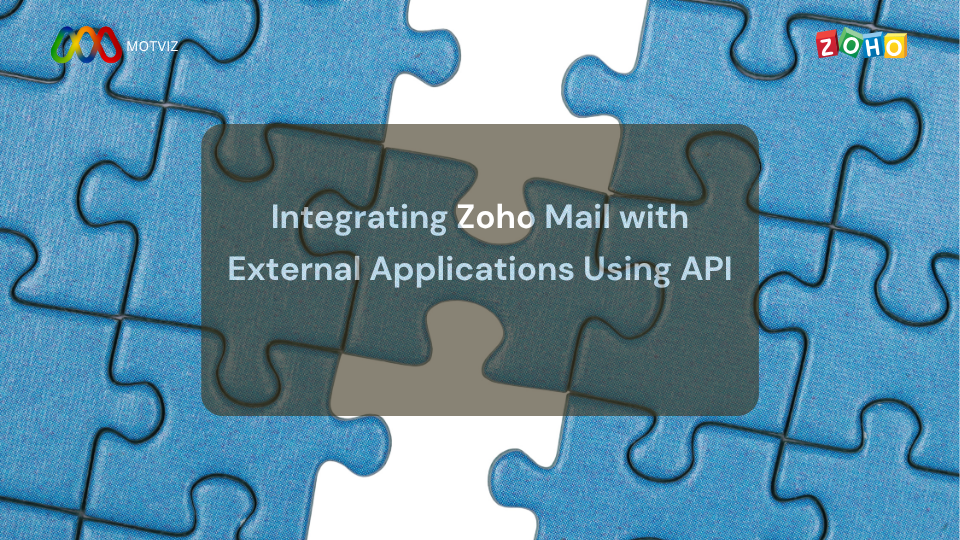
Integration of Zoho Mail With External Applications Using API
Synopsis
Zoho Mail is an email platform yet it is an API-based platform that allows developers to integrate it with external applications. You might want to automate email communication, pull data from the mailbox, and create some custom workflows for your third-party system such as CRM or ERP. Zoho Mail REST APIs allow great flexibility.
This blog intends to show how to integrate Zoho Mail with an external application using Zoho Mail API. We shall discuss the basic steps like authentication, key endpoints, and interesting use cases.
Why Integrate Zoho Mail with External Applications?
Some of the possibilities for integration include:
- · Auto-send or schedule emails from your application
- · Read incoming emails on predefined filters (for ticket or lead systems)
- · Manage folders, contacts, and drafts
- · Syncing records of the CRM or task workflows
Step 1: Generate Authentication Token Zoho Mail API is using OAuth 2.0 security authentication.
OAuth Setup: Go to Zoho API Console
Create a new client:
Client Type: Server-based Redirect URI: https://www.yourapp.com/oauth/callback
Keep the client_id and client_secret handy
Get Access Token: bash Copy Edit POST https://accounts.zoho.com/oauth/v2/token ?grant_type=authorization_code &client_id=YOUR_CLIENT_ID &client_secret=YOUR_CLIENT_SECRET &redirect_uri=YOUR_REDIRECT_URI &code=AUTH_CODE Response will contain your access_token and refresh_token
Step 2: Sample API Call – Sending Email
Send Mail endpoint is used to automate email dispatching from your system.
POST https://mail.zoho.com/api/accounts/{account_id}/messages
Headers:
Authorization: Zoho-oauthtoken {access_token}
Content-Type: application/json
Body:
{
“fromAddress”: “yourmail@yourdomain.com”,
“toAddress”: “client@example.com”,
“subject”: “Welcome to Our Service”,
“content”: “Thank you for registering with us.”
}
Step 3: Sample API Request – Send Email
Use the Send Mail endpoint to automate email dispatching from your system.
POST https://mail.zoho.com/api/accounts/{account_id}/messages
Headers:
Authorization: Zoho-oauthtoken {access_token}
Content-Type: application/json
Body:
{
“fromAddress”: “yourmail@yourdomain.com”,
“toAddress”: “client@example.com”,
“subject”: “Welcome to Our Service”,
“content”: “Thank you for registering with us.”
}
Step 4: Fetch Inbox Messages
Example: Retrieve the latest messages for a logged-in user.
http
CopyEdit
GET https://mail.zoho.com/api/accounts/{account_id}/messages/view Headers: Authorization: Zoho-oauthtoken {access_token}
This can be used in a ticketing system or to log customer queries into your database.
Step 5: Use Case – CRM + Zoho Mail Integration
Imagine integrating Zoho Mail with a CRM like Zoho CRM or Salesforce. You can:
- · Auto-fetch incoming emails and attach to lead records
- · Auto-send templated responses on lead creation
- · Maintain conversation threads for each customer
Best Practices
- · Always refresh tokens before expiry
- · Use webhook notifications to track new emails
- · Encrypt stored tokens and keys
- · Implement retry logic for failed API calls
Useful Links
- · Zoho Mail API Docs
- · Zoho OAuth Guide
Conclusion
Integrating Zoho Mail using its API unlocks a range of automation and communication opportunities for your external applications. Whether you’re working on custom workflows or building scalable integrations with CRMs, Zoho Mail APIs are reliable and flexible enough for complex scenarios.
For any integration support or custom solutions, feel free to connect!




